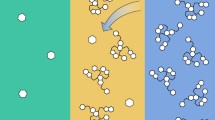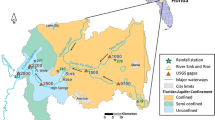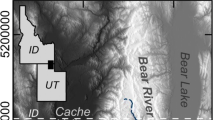Abstract
The close interplay between hydraulic and biotic processes controls the evolution of ecosystems in large, circumboreal peatlands and the degree to which they lose, gain or sequester carbon. In peatlands, biota significantly alters surficial acid–base equilibrium and solute chemistry by releasing dissolved organic compounds into surface and pore waters, which then mix through advection and dispersion through pore water flow paths.
We report herein the results of new geochemical mixing models that incorporates organic acid dissociation constants to understand how organic acids control the acid–base chemistry in mixtures of dilute acidic bog pore waters and circum-neutral groundwater (typical of carbonate terrains) that upwells or disperses into peat deposits.
In our new mixing models, at least twice as much groundwater is required to neutralize bog water acidity when dissolved organic carbon concentrations exceed 10 mmol/L than in their absence. Although it remains uncertain how future climatic change will alter the composition of dissolved organic matter in peatlands, organic acids should remain an important factor with respect to potential neutralization of peatland waters by groundwater sources. The acid base equilibria in large peat basins not only has important implications for vegetation patterning but also for biogeochemical cycles in these globally important reservoirs for carbon.





Similar content being viewed by others
References
Baker DG, Kuehnast EL, Zandlo JA (1985) Climate of Minnesota. Part XV Normal temperatures 1951–1980 and their application. University of Minnesota Agriculture Experiment Station AD SB-2777–2985
Berner EK, Berner RA (2012) Global environment: water, air, and geochemical cycles. Princeton University Press, Princeton
Breemen NV (2003) How Sphagnum bogs down other plants. Trends Ecol Evol 10:270–275
Chason DB, Siegel DI (1986) Hydraulic conductivity and related physical-properties of peat, lost River Peatland. North Minn Soil Sci 142:91–99
Clymo RS, Hayward PM (1982).The ecology of Sphagnum. In: Smith, A.J.E. (Ed), Bryophyte Ecology, Chapman & Hall, pp. 229–289
Driscoll CT, Lehtinen MD, Sullivan TJ (1994) Modeling the acid–base chemistry of organic solutes in Adirondack, New York, lakes. Water Resour Res 30:297–306
Ferry J (ed) (1993) Methanogenesis: ecology, physiology, biochemistry, & genetics. Chapman & Hall Inc., New York
Glaser PH (1992) Vegetation and water chemistry in the patterned peatlands of Minnesota. In: Wright HE Jr, Coffin BA, Aaseng NE (eds) The patterned Peatlands of Minnesota. University of Minnesota Press, Minneapolis, pp 15–26
Glaser PH, Wheeler GA, Gorham E, Wright HE Jr (1981) The patterned peatlands of the Red Lake peatland, northern Minnesota: vegetation, water chemistry, and landforms. J Ecol 69:575–599
Glaser PH, Janssens JA, Siegel DI (1990) The response of vegetation to chemical and hydrological gradients in the Lost River Peatlands, Northern Minnesota. J Ecol 78:1021–1048
Glaser PH, Siegel DI, Shen Y, Romanowicz EA (1997) Regional linkages between raised bogs and groundwater flow systems in the Glacial Lake Agassiz region of northern Minnesota. J Ecol 85:91–99
Glaser PH, Hansen BCS, Siegel DI, Reeve AS, Morin PJ (2004a) Rates, pathways and drivers for peatland development in the Hudson Bay Lowlands, northern Ontario. Can J Ecol 92:1036–1053
Glaser PH, Siegel DI, Reeve AS, Janssens JA, Janecky DR (2004b) Tectonic drivers for vegetation patterning and landscape evolution in the Albany River region of the Hudson Bay Lowlands. J Ecol 92:1054–1070
Glaser PH, Chanton JP, Morin P, Rosenberry DO, Siegel DI, Ruud O, Chasar LI, Reeve AS (2004c) Surface deformations as indicators of deep ebullition fluxes in a large northern peatland, global Biogeochem. Cycles 18:GB1003. doi:10.1029/2003GB00206
Gorham E, Eisenreich SJ, Ford J, Santelmann MV (1985) Chemistry of bog waters. In: Stumm, W. (Ed.), The Chemical Processes in Lakes, pp. 330–363
Hemond HF (1980) Biogeochemistry of Thoreau’s Bog, Concord. Mass Ecol Monogr 50:507–526
Langmuire D (1997) Aqueous environmental geochemistry. Prentice Hall, New Jersey, p 600
Parkhurst DL, Appelo CAJ (1999) User’s guide to PHREEQC - a computer program for speciation, reaction-path, advective-transport, and inverse geochemical calculations. US Geol Surv Water Resour Investig Rep 99–4259
Reeve AS, Siegel DI, Glaser PH (1996) Geochemical controls on peatland pore water from the Hudson Bay Lowland: a multivariate statistical approach. J Hydrol 181:285–304
Reeve AS, Siegel DI, Glaser PH (2001) Simulating dispersive mixing in large peatlands. J Hydrol 242:103–114
Romanowicz EA, Siegel DI, Chanton JP, Glaser PH (1995) Temporal variations in dissolved methane deep in the Lake Agassiz peatlands, Minnesota (USA). Global Biogeochem Cycles 9:197–212
Shotyk B (1988) Review of the inorganic geochemistry of peats and peatland waters. Earth Sci Rev 25:95–176
Siegel DI (1983) Ground water and evolution of patterned mires, Glacial Lake Agassiz Peatlands, Northern Minnesota. J Ecol 71:913–921
Siegel DI, Glaser PH (1987) Groundwater flow in a bog-fen complex, Lost river peatland, northen Minnesota. J Ecol 75:743–754
Siegel DI, Reeve A, Glaser PH, Romanowicz E (1995a) Climate-driven flushing of pore water from humified peat: geochemical and ecological ramifications. Nature 374:531–533
Siegel DI, Reeve AS, Glaser PH, Romanowicz EA (1995b) Climate-driven flushing of pore-water in peatlands. Nature 374:531–533
Siegel DI, Glaser PH, So J, Janecky DR (2006) The dynamic balance between organic acids and circumneutral groundwater in a large boreal peat basin. J Hydrol 320:421–431
Spearing AM (1972) Cation-exchange capacity and glacturonic acid content of several species of Sphagnum in sandy ridge bog, central New York State. Bryol 75:1148–1154
Thurman EM (1985) Organic geochemistry of natural waters. Martinus Nitinus Nijhoff/Dr. W. Junk Publisher, Dordrecht, p 507
Acknowledgments
We thank the National Science Foundation for supporting this research effort.
Author information
Authors and Affiliations
Corresponding author
Electronic supplementary material
Below is the link to the electronic supplementary material.
ESM 1
(PDF 48 kb)
Rights and permissions
About this article
Cite this article
Dasgupta, S., Siegel, D.I., Zhu, C. et al. Geochemical Mixing in Peatland Waters: The Role of Organic Acids. Wetlands 35, 567–575 (2015). https://doi.org/10.1007/s13157-015-0646-2
Received:
Accepted:
Published:
Issue Date:
DOI: https://doi.org/10.1007/s13157-015-0646-2




